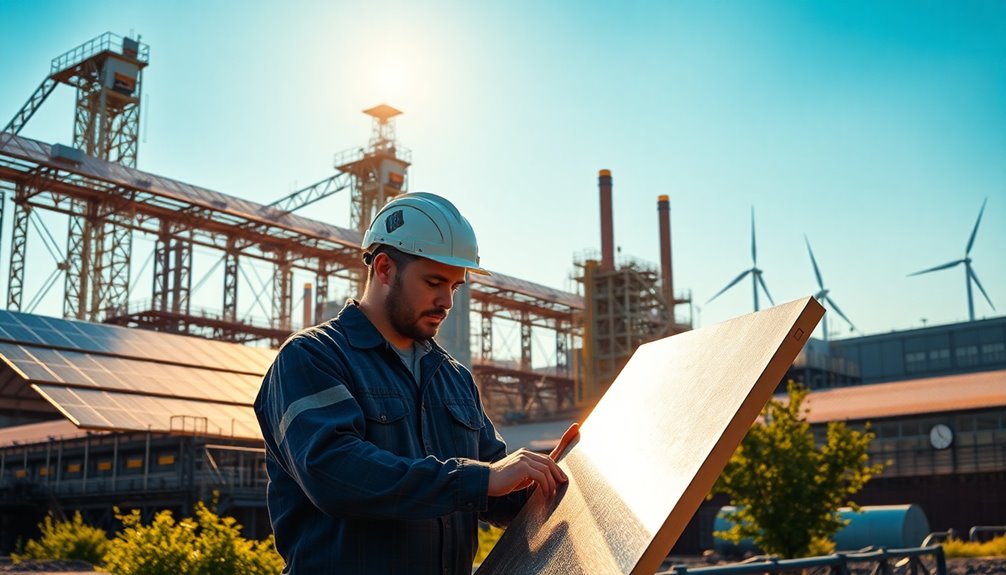The EU's future really hinges on clean steel rather than traditional industrial might. By shifting towards hydrogen-based steelmaking, the EU aims for an ambitious 80-95% emissions reduction by 2050. This transition not only creates jobs but also aligns with economic resilience. High energy costs and global competition are challenges, but the emerging market for green steel presents new opportunities. If you're curious about how this shift impacts the economy, there's more to explore.
Key Takeaways
- The EU aims to cut emissions by 80-95% by 2050, emphasizing clean steel production over traditional industrial practices.
- Hydrogen-based steelmaking is projected to account for 30% of production by 2030, reducing fossil fuel dependency.
- Investment in clean steel technologies will reach €2.6 billion by 2030, enhancing innovation and sustainability.
- The growing market for green steel indicates consumer readiness to pay more for environmentally responsible products.
- Addressing high energy costs and global competition is vital for the steel industry's sustainable future in Europe.

As the EU sets ambitious decarbonisation targets for its steel industry, you might wonder how this sector will navigate the challenges ahead. The steel industry, a cornerstone of Europe's economy, generates over 330,000 direct jobs and contributes a staggering €191 billion annually. However, with the goal of cutting emissions by 80-95% by 2050 compared to 1990 levels, the road to sustainability is fraught with challenges.
In 2020, around 56% of EU steel was produced through primary methods, but by 2030, about 30% of that production is expected to transition to hydrogen-based steelmaking. This shift is crucial, as the EU has ramped up clean steel projects from 23 in 2021 to 38 in 2023. The focus on hydrogen represents a pivotal strategy in reducing reliance on fossil fuels while fostering innovation. This transition aligns with the REPowerEU plan to achieve significant decarbonisation of primary steel production.
The Clean Steel Partnership plans to invest around €2.6 billion in research and development by 2030, aiming to create breakthrough technologies. You'll also notice a doubling of green hydrogen projects, reflecting a commitment to cleaner energy sources, while blue hydrogen projects have significantly decreased. This shift indicates a clear direction toward sustainable practices.
Yet, the industry faces significant hurdles, including high energy costs and global competition. Tariffs and import pressures from non-EU countries add to the complexity of maintaining competitiveness. The European Steel Association (EUROFER) emphasizes the need for robust action plans to address these challenges head-on.
Despite these obstacles, there's an emerging market for green steel, with consumers willing to pay a premium for environmentally friendly products. The ongoing discussions about Carbon Border Adjustment Mechanisms (CBAM) also signal a proactive approach to ensuring that non-green steel doesn't undermine EU efforts.
In this evolving landscape, the EU's future in steel lies not in industrial might or military applications, but in embracing clean steel as a pathway to sustainability and economic resilience.
Frequently Asked Questions
What Are the Environmental Benefits of Clean Steel Production?
Clean steel production offers several environmental benefits.
You'll see a significant reduction in CO2 emissions, helping combat climate change. By using renewable energy and technologies like hydrogen-powered production and electric arc furnaces, the carbon footprint shrinks.
Recycling materials enhances sustainability, reducing waste and energy consumption. Additionally, implementing carbon capture technologies allows for further emissions mitigation, making steel production more eco-friendly and aligning with global goals for a cleaner, greener future.
How Does Clean Steel Impact Job Creation in the EU?
When it comes to job creation, clean steel's a game changer.
Transitioning to green technologies not only secures existing jobs but also opens doors to new opportunities in research and manufacturing.
As the EU pushes for decarbonisation, you can expect a surge in demand for skilled labor, especially in sectors like automotive and construction.
This shift promises long-term job stability while fostering a sustainable economy that benefits everyone.
What Technologies Are Used in Clean Steel Manufacturing?
In clean steel manufacturing, you'll find several innovative technologies at play.
Molten Oxide Electrolysis (MOE) uses renewable electricity to produce iron without harmful byproducts.
Direct Reduced Iron (DRI) utilizes low-carbon hydrogen, while Electric Arc Furnaces (EAFs) melt scrap steel, minimizing fossil fuel use.
Additionally, Carbon Capture, Utilization and Storage (CCUS) captures CO₂ emissions, and hydrogen-based ironmaking employs hydrogen to lower carbon output.
These technologies pave the way for more sustainable steel production.
How Can Consumers Support the Transition to Clean Steel?
Did you know that by 2030, the automotive sector is expected to demand a staggering amount of low-emissions steel?
You can support the transition to clean steel by choosing products made from sustainable materials, urging companies to commit to greener practices, and advocating for policies that promote clean production.
Your voice matters—when you demand transparency and sustainability, you push industries to adopt innovative technologies, leading to a healthier planet for everyone.
What Role Do Other Industries Play in the Clean Steel Initiative?
You play a vital role in supporting the clean steel initiative through various industries.
The construction sector benefits from recycled steel, promoting sustainability in building materials.
In the automotive industry, clean steel enhances vehicle efficiency and decarbonization efforts.
Renewable energy integration is crucial for reducing emissions in steel production.
Finally, the defense sector relies on innovative clean steel for advanced equipment, ensuring both security and economic growth.
Your engagement can drive these changes forward.
Conclusion
In a world where industrial might often overshadows innovation, the EU's future hinges on clean steel, not outdated tanks. While some cling to the past, you can embrace a sustainable future that balances economic growth with environmental responsibility. By prioritizing green technologies over traditional power, you're not just reshaping industries; you're redefining progress. The choice is clear: you can either forge ahead with old weapons or build a cleaner, brighter world with every steel beam.









